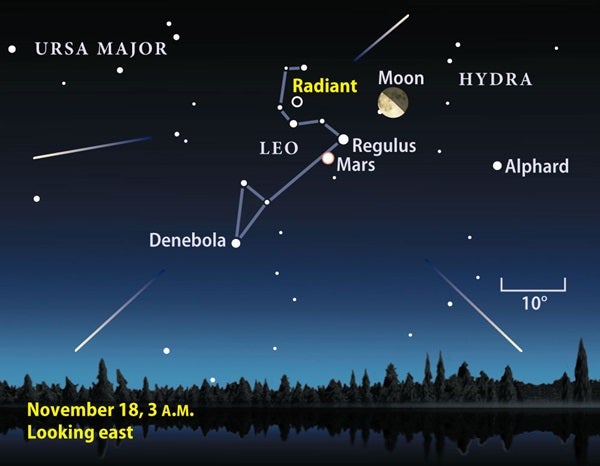For meteor mavens, the month of November means only one thing: the return of the Leonid meteor shower. The annual event, known for its occasional wild swings in activity from year to year, peaks before dawn November 18. Unfortunately, that’s just when a Last Quarter Moon lies near the shower’s originating point, or radiant, in Leo the Lion.
“Some years, the Leonids brighten the sky with storms of shooting stars,” says Astronomy Senior Editor Richard Talcott. “Other years, like this one, astronomers expect the event to be muted, with observers under a dark sky seeing up to 10 meteors per hour.” That doesn’t mean the shower won’t be worth watching, of course — just that it might not be as spectacular as some past Leonid showers.
The yearly event owes its origin to Comet 55P/Tempel-Tuttle, which ejects tiny specks of dust and debris during its many trips (lasting just over 33 years) around the Sun. When Earth passes through this stream of dust, the tiny particles streak through our atmosphere at some 158,000 mph (255,600 km/h), quickly vaporizing because friction with the air creates an incandescent column of gas that we see as the meteor.
“Interested observers who hope to make the most of this year’s fair conditions should head to the country, or other rural areas, and face away from the Moon after it rises,” says Talcott. “Even an ‘ordinary’ meteor shower can provide a memorable experience for skygazers, so go out and see what you can the night of November 17/18. You’ll have to wait another year if you miss it.”
Meteor fast facts:
- Most visible meteors lie within 120 miles (200 kilometers) of an observer.
- Meteors become visible at an average height of 55 miles (90km). Nearly all burn up before they reach an altitude of 50 miles (80km).
- No known meteorite has been associated with a meteor shower. (That is, no shower meteor has ever survived its flight through the atmosphere and been recovered.)
- The typical bright meteor is produced by a particle weighing less than 1 ounce with a size no larger than a pea.
- Scientists estimate the average total mass of meteoritic material entering Earth’s atmosphere to be between 100 and 1,000 tons (91,000–910,000 kilograms) per day.
- The hourly rate on a “non-shower” night is approximately 6 meteors per hour.
- A meteoroid enters the atmosphere at velocities between 25,000 and 165,000 mph (40,300–265,000 km/h).
- Video: How to observe meteor showers, with Michael E. Bakich, senior editor
- Video: Easy-to-find objects in the 2011 autumn sky, with Michael E. Bakich, senior editor
- StarDome: Locate the constellation Leo the Lion in your night sky before this meteor shower with our interactive star chart.
- Sign up for our free weekly e-mail newsletter.












